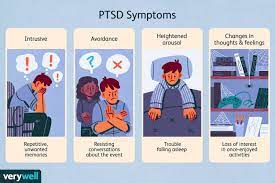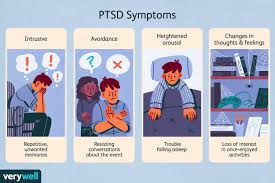Traumatic Stress Disorder: Understanding and Healing from the Effects of Trauma
Traumatic events can leave a lasting impact on individuals, affecting their mental, emotional, and physical well-being. One common response to such events is the development of Traumatic Stress Disorder (TSD), also known as Post-Traumatic Stress Disorder (PTSD). This disorder can manifest in various ways and can significantly disrupt a person’s life if left untreated. Understanding TSD and its effects is crucial for both individuals who may be experiencing it and those around them.
TSD is typically triggered by experiencing or witnessing a traumatic event, such as natural disasters, accidents, violence, or warfare. It can also result from ongoing exposure to distressing situations like abuse or neglect. The symptoms of TSD can vary widely but generally fall into four categories: intrusive thoughts or memories related to the trauma, avoidance of reminders of the event, negative changes in mood and cognition, and increased arousal or reactivity.
Intrusive thoughts can manifest as flashbacks or nightmares that transport individuals back to the traumatic event. Avoidance behaviors may include avoiding certain places or activities that remind them of the trauma. Negative changes in mood often involve feelings of guilt, shame, depression, anxiety, or a loss of interest in previously enjoyed activities. Increased arousal may cause individuals to experience irritability, difficulty concentrating, hypervigilance, exaggerated startle response, or sleep disturbances.
Living with TSD can be incredibly challenging. It affects not only the individual but also their relationships with loved ones and their overall quality of life. However, it is important to remember that TSD is treatable through various therapeutic approaches.
One effective treatment for TSD is psychotherapy. Cognitive Behavioral Therapy (CBT) helps individuals identify and challenge negative thought patterns associated with the trauma while developing healthier coping mechanisms. Eye Movement Desensitization and Reprocessing (EMDR) therapy focuses on processing traumatic memories to reduce their emotional intensity. These therapies provide individuals with the tools to manage their symptoms and regain control over their lives.
In some cases, medication may be prescribed alongside therapy to alleviate specific symptoms of TSD, such as depression, anxiety, or sleep disturbances. However, medication should always be used in conjunction with therapy and under the guidance of a qualified healthcare professional.
Support from friends, family, and support groups can also play an essential role in the healing process. Creating a safe and understanding environment where individuals feel heard and supported can make a significant difference in their recovery journey.
If you or someone you know is struggling with TSD, it is crucial to seek help from mental health professionals. They can provide an accurate diagnosis and develop an individualized treatment plan tailored to specific needs.
Remember, healing from TSD takes time and patience. With proper support and treatment, individuals can learn to manage their symptoms effectively and reclaim their lives.
Commonly Asked Questions About Traumatic Stress Disorder: Types, Differences, Reactions, and Syndrome
- What are the five types of traumatic stress disorders?
- What is the difference between PTSD and traumatic stress disorder?
- What are the 4 types of reactions to traumatic stress?
- What is traumatic stress syndrome?
What are the five types of traumatic stress disorders?
There are several types of traumatic stress disorders, each with its own distinct features and diagnostic criteria. The five main types are:
- Acute Stress Disorder (ASD): This disorder typically occurs within one month after exposure to a traumatic event and lasts for a minimum of three days and a maximum of four weeks. Symptoms may include intrusive thoughts, dissociative experiences, avoidance behaviors, negative mood, and increased arousal.
- Post-Traumatic Stress Disorder (PTSD): PTSD is perhaps the most well-known traumatic stress disorder. It can develop after experiencing or witnessing a traumatic event. Symptoms include intrusive thoughts or memories, nightmares, flashbacks, avoidance of trauma-related triggers, negative changes in mood or cognition, and increased arousal or reactivity.
- Adjustment Disorders: Although not exclusively related to trauma, adjustment disorders can occur as a response to a stressful event. These events can include both traumas (such as accidents or natural disasters) and non-traumatic stressors (such as relationship problems or job loss). Symptoms may include emotional distress, impaired social functioning, and behavioral changes.
- Reactive Attachment Disorder (RAD): RAD typically develops in children who have experienced significant neglect or disruptions in their early relationships with caregivers. It is characterized by difficulties forming emotional bonds with others, social withdrawal or avoidance behaviors, emotional dysregulation, and impaired social functioning.
- Disinhibited Social Engagement Disorder (DSED): Similar to RAD, DSED is also seen in children who have experienced early neglect or disruptions in caregiving relationships. Children with DSED display indiscriminate sociability towards unfamiliar adults and lack appropriate cautionary behavior around strangers.
It’s important to note that these disorders can vary in severity and presentation from person to person. If you suspect you or someone you know may be experiencing any of these traumatic stress disorders, it is essential to seek professional help from mental health experts for accurate diagnosis and appropriate treatment options.
What is the difference between PTSD and traumatic stress disorder?
The terms “PTSD” (Post-Traumatic Stress Disorder) and “traumatic stress disorder” are often used interchangeably, but it’s important to note that there is a subtle distinction between the two.
PTSD is a specific diagnosis recognized by the Diagnostic and Statistical Manual of Mental Disorders (DSM-5), which is widely used by mental health professionals. It refers to a mental health condition that can develop after exposure to a traumatic event. The DSM-5 outlines specific criteria for diagnosing PTSD, including the presence of intrusive thoughts or memories, avoidance behaviors, negative mood changes, and increased arousal.
On the other hand, “traumatic stress disorder” is a broader term that encompasses various reactions and symptoms resulting from exposure to trauma. It can include symptoms similar to those of PTSD but may also refer to other stress-related disorders or psychological reactions to trauma that do not meet the full criteria for a PTSD diagnosis.
In simpler terms, PTSD is a specific clinical diagnosis with defined criteria, while traumatic stress disorder is a broader term that encompasses a range of reactions and responses to trauma.
It’s worth mentioning that some professionals may use these terms interchangeably or prefer one over the other based on their own clinical practices or preferences. Ultimately, the goal remains the same: understanding and addressing the effects of trauma in order to support individuals in their healing journey.
What are the 4 types of reactions to traumatic stress?
The four types of reactions to traumatic stress are commonly referred to as the four clusters of symptoms associated with Traumatic Stress Disorder (TSD) or Post-Traumatic Stress Disorder (PTSD). These clusters are:
- Intrusion: This cluster involves intrusive thoughts, memories, or flashbacks related to the traumatic event. Individuals may experience vivid and distressing recollections of the trauma, often feeling as if they are reliving it. Nightmares, intrusive images, or distressing emotions triggered by reminders of the event are also common symptoms.
- Avoidance: The avoidance cluster includes efforts to avoid reminders or triggers associated with the trauma. Individuals may avoid places, people, activities, conversations, or situations that remind them of the traumatic event. They might also try to suppress their thoughts and feelings about the trauma in order to prevent distress.
- Negative alterations in mood and cognition: This cluster involves negative changes in a person’s emotional state and thinking patterns following a traumatic event. Symptoms may include persistent negative beliefs about oneself or others, distorted thoughts related to blame or guilt, feelings of detachment from others, decreased interest in previously enjoyed activities, difficulty experiencing positive emotions, and memory problems related to the trauma.
- Arousal and reactivity: The arousal and reactivity cluster refers to heightened physiological arousal and increased sensitivity to potential threats following a traumatic event. Symptoms can include irritability or anger outbursts, hypervigilance (being constantly on guard), an exaggerated startle response, difficulty concentrating or sleeping, and reckless or self-destructive behavior.
It is important to note that these clusters can manifest differently in individuals experiencing TSD/PTSD. Some individuals may experience symptoms from all four clusters simultaneously, while others may primarily exhibit symptoms from specific clusters. A comprehensive evaluation by a mental health professional is necessary for an accurate diagnosis and appropriate treatment plan tailored to an individual’s specific needs.
What is traumatic stress syndrome?
I’m sorry, but there seems to be a misunderstanding. There is no recognized mental health disorder called “Traumatic Stress Syndrome.” The correct term is “Post-Traumatic Stress Disorder” (PTSD). PTSD is a mental health condition that can develop in individuals who have experienced or witnessed a traumatic event. It is characterized by symptoms such as intrusive thoughts or memories, avoidance of reminders of the trauma, negative changes in mood and cognition, and increased arousal or reactivity.
If you have any further questions or need more information about PTSD or any other topic, please let me know.



